Exploring the Mystery of Moving Rocks in Death Valley
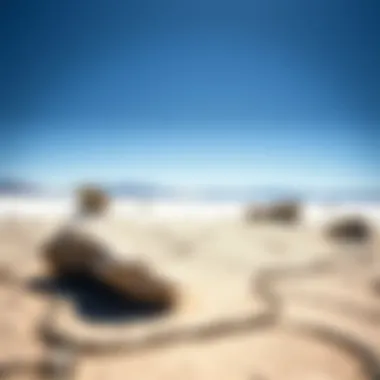
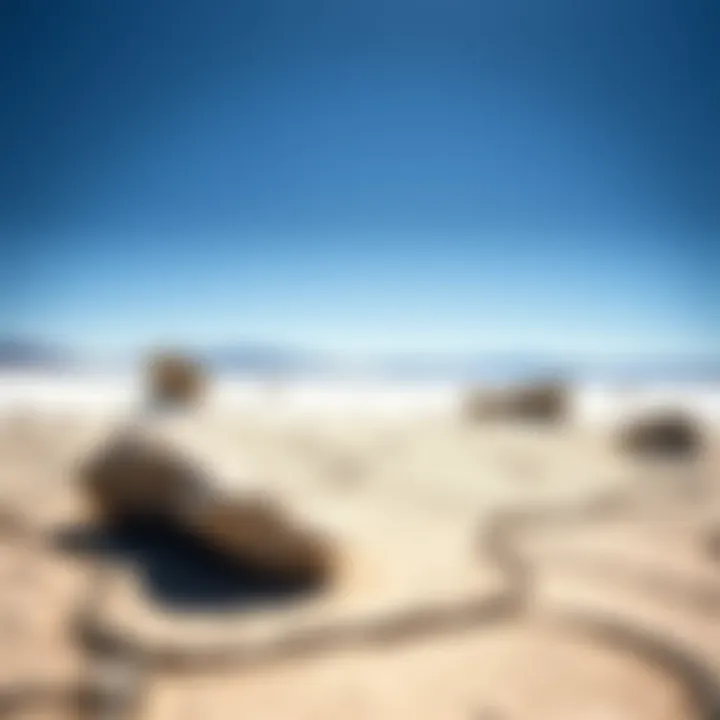
History and Origins
Death Valley is a land of extremes, and its enigmatic moving rocks are no exception. The natural spectacle of stones seemingly gliding across the barren desert floor piques the curiosity of scientists and visitors alike. Understanding the historical context of these rocks allows for a deeper appreciation of not just their behavior, but also the surrounding environment.
Overview of Collectibles, Rocks, and Fossils
These wandering stones are not just geological anomalies; they fall into a broader category of collectibles and natural artifacts. Enthusiasts often seek out unique rocks and fossils in this vast desert, with a keen eye for distinguishing the different types. The moving rocks, with their distinctive trails, become a focal point for rock collectors who wish to understand their significance beyond mere aesthetics.
In this region, collectors can find various types of rocks, including racetrack rocks—those famous for their inexplicable movement. Fossils in the area, although not directly related to the moving stones, are abundant. They serve as a reminder of the region’s tumultuous geological past, revealing layers of history that speak to the Earth's transformations.
Historical Significance and Cultural Impact
Historically, the phenomenon of moving rocks has captivated researchers and naturalists. In the early 20th century, several scientists ventured into Death Valley to understand this unusual event. The most notable explorations occurred in the 1940s when studies about the phenomenon gained traction, leading to various hypotheses about the mechanics at play.
Culturally, these rocks have inspired folklore and local legends, infusing the landscape with stories and intrigue. The very thought of rocks that move on their own invokes a sense of magic and wonder, enhancing the allure of Death Valley for tourists and explorers alike. These tales contribute to the rich narrative of place, binding together scientific inquiry and local tradition.
"The stories told about the moving rocks add a layer to the experience that is both intriguing and educational, cementing Death Valley as a key destination for exploration."
Identification and Classification
As collectors and enthusiasts delve deeper into the moving rock phenomenon, understanding how to identify and classify these unique geological features becomes crucial.
Guide to Identifying Rocks and Fossils
When it comes to identifying the moving rocks of Death Valley, keen observation is essential. Here are some pointers:
- Look for trails: The most telling feature of these rocks is the tracks they leave behind. Observing the direction and nature of the trails can help in understanding their movement.
- Check the textures: The surface texture of the rocks varies and often indicates how long they've been moving. Smoother stones might suggest more frequent movement.
- Color patterns: Colors can range from a dull brown to a striking black, with variations capturing the uniqueness of each rock.
Common Types and Variations
Among the rocks that traverse the dry lake bed, the following types are often recognized:
- Racetrack rocks: These are perhaps the most famous. They glide in a manner that creates continuous trails on the cracked earth.
- Small pebble stones: These stones typically show less pronounced movement but can still exhibit shifting characteristics.
- Larger boulders: Often less mobile, these rocks hold historical geological significance, telling the story of the region's ancient landscapes.
- Fossilized remains: Occasionally found in proximity to the moving rocks, these fossils provide further insights into the area’s biodiversity and geological history.
Finale
The wonder of the moving rocks in Death Valley is a mix of natural phenomena and human fascination. Their historical and cultural contexts enrich our understanding and appreciation of this remarkable desert landscape. As enthusiasts explore the science behind the phenomenon alongside the richness of the surrounding environment, they uncover stories etched in the stones themselves.
For further reading on the geology of Death Valley, visit National Park Service and explore additional insights from geological surveys highlighting the area's illustrious past.
Prolusion to Death Valley
Death Valley, a name that evokes a sense of mystery and intrigue, holds more than just an ominous title. Its unique geography and extreme environment serve as a backdrop to one of nature’s most curious phenomena: moving rocks. Understanding this desolate yet captivating region is crucial, as it lays down the foundation for exploring how the rocks traverse the rugged landscape.
The significance of Death Valley goes beyond its surface allure. As one of the hottest places on Earth, it showcases a variety of geological features, climatic conditions, and ecological systems that make it a vital area for scientific research. The astonishing landscape—complete with salt flats, sand dunes, and mountains—provides a rich context for observing natural phenomena that seem to defy logic.
In examining Death Valley, we delve not only into its geographical features but also its history and cultural significance. The indigenous peoples, who have called this land home for centuries, hold a connection to the environment that is important to acknowledge. Furthermore, Death Valley’s historical background provides insight into how it has shaped human interactions and explorations over time.
By focusing on the intriguing phenomenon of moving rocks, we can gain insights into geological processes that might not be visible at first glance. The understanding of these landscapes and their mysterious behaviors opens up discussions about the interconnectedness of nature and the scientific principles that govern them. It’s an exciting venture into a place where earth science meets curiosity, drawing in both seasoned geologists and rock enthusiasts alike.
"Understanding where the moving rocks lie is key to delving deeper into the reasons they move."
Thus, in this piece, we set out to investgate every nuance of this interesting location and the phenomena associated with it, making the connection between the land and the science behind the moving rocks.
Geographical Overview
Death Valley stretches across California and Nevada, encompassing a vast expanse of 3.4 million acres of diverse terrain. It’s the lowest point in North America, sinking to 282 feet below sea level, while the surrounding peaks ascend to well over 11,000 feet, creating a dramatic elevation gradient. The valley's sharp contrasts—baking-hot summers and freezing winters—are notable features that contribute to its distinctive climate.
This region is enriched with varied geological formations, which stem from tectonic forces, erosion, and sedimentation over millions of years. Death Valley is characterized by its dry lake beds, such as the Racetrack Playa, where rocks appear to slide across the surface, leaving behind enigmatic trails. Such geographical attributes not only form a playground for geologists but also invite tourists and researchers alike to witness the marvels of nature firsthand.
Particularly, the Racetrack Playa acts as an open-air laboratory, where various studies on planetary geology have been conducted. The landscape, scattered with boulders and gravelly expanses, allows for observations that connect Earth with dynamics operating on other celestial bodies.
History and Significance
The history of Death Valley is as layered as its geology. The area has long been inhabited by Native American tribes, such as the Timbisha Shoshone, who used the land’s resources for sustenance. The name "Death Valley" itself originated during the California Gold Rush when a group of pioneers mistakenly traversed the area in 1849. The harsh conditions almost claimed their lives, but they eventually escaped, giving the valley a rather grim moniker.
From a scientific perspective, the valley has become a hotspot for research over the past century. Early observations of the moving rocks intrigued travelers and scientists alike, sparking interest in documenting the phenomenon. As technology advanced, so did the methods employed to study the mechanics behind the rock movements.
Today, various studies have substantiated our understanding of these natural occurrences, noting that they pose critical questions about Earth’s geology and environmental changes. The popularity of Death Valley, bolstered by significant scientific milestones, underscores its reputation as a key site for geological exploration, captivating both the public and experts in the field.
Thus, understanding the history and geographical significance of Death Valley is fundamental as it shapes how we perceive the movements of rocks and their intriguing mysteries.
Related Resources:
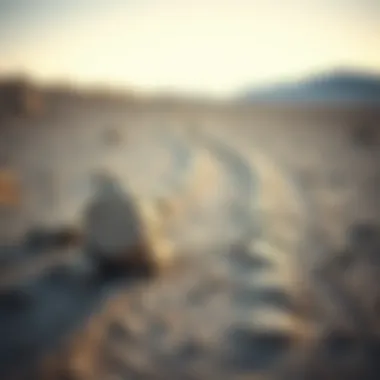
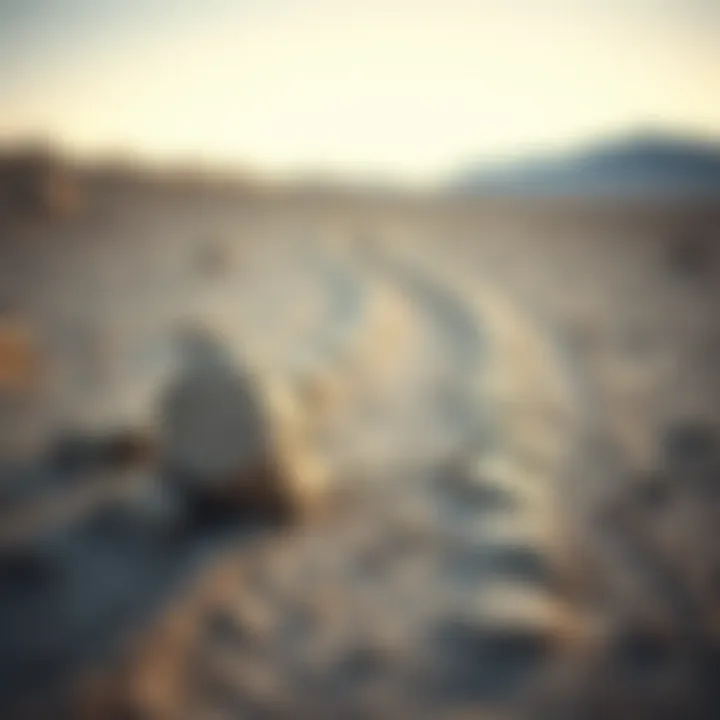
- Death Valley National Park - National Park Service
- Racetrack Playa and the Moving Rocks - Wikipedia
- Exploring Death Valley - Britannica
- Death Valley on Reddit
- Timbisha Shoshone Tribe - Official Website
Understanding the Moving Rocks
The phenomenon of moving rocks in Death Valley is a captivating subject that merges science with a dash of mystery. This section seeks to unpack the mechanics behind these wandering stones while highlighting their significance in geographical and geological studies. Understanding how and why these rocks move is not just about satisfying curiosity; it has broader implications for the understanding of Earth’s systems and climate.
Defining the Phenomenon
At first glance, the sight of rocks seemingly gliding across the arid expanse of the Racetrack Playa baffles both scientists and casual observers alike. The phenomenon is characterized by large stones that leave visible trails behind them on the cracked earth, suggesting that they are, in fact, in motion. The act of moving, however, doesn't happen in the dead of night or in silence; rather, it is influenced by climatic conditions, soil composition, and even subtle geological forces.
To define the phenomenon, researchers have identified specific criteria:
- Movement Patterns: Rocks shift in unique, often straight lines, which raises questions about the mechanisms at play.
- Environmental Triggers: The interplay of wind and water enhances our understanding of how rocks can traverse the landscape.
- Innovative Methods: Various studies have utilized technology, such as GPS tracking, to map out the patterns of movement more accurately.
As fascinated onlookers observe the trails left by these stones, it raises intriguing thoughts about the challenges in understanding natural phenomena that defy conventional explanations.
Geological Background
A critical component of the moving rocks phenomenon lies in the geological landscape of Death Valley itself. This area is punctuated by distinct geological features, ranging from ancient lake beds to vast salt flats. The geology plays a foundational role in shaping both the environment and the unique characteristics of the rocks that inhabit it.
- Lake Bed Formation: The Racetrack Playa was once a lake, which contributes to the composition of minerals found in the soil. When the lake evaporated, it left behind a crust of clay and salt that sets the stage for the movement.
- Rock Composition: The rocks themselves, primarily basalt, exhibit varying densities and weights that affect how they react under environmental conditions.
- Tectonic Activity: Death Valley is situated along a fault line, introducing an additional layer of complexity regarding the forces acting on the rocks.
Understanding the geological background provides a lens through which one can appreciate why certain conditions facilitate rock movement, while others do not. By investigating the interplay between geology and movement, we gain a richer understanding of our planet’s dynamics and its environmental history.
Historical Context of the Research
Understanding the historical context surrounding the moving rocks phenomenon in Death Valley is key for anyone delving into the depths of this captivating subject. It’s not just about the rocks and their mysterious locomotion; it’s about the tapestry of inquiry and investigation that has unfolded over decades. This exploration encompasses early observations made by curious onlookers, leading up to significant research milestones that have illuminated the science behind this natural peculiarity.
The first importance lies in appreciating how human curiosity has spurred scientific understanding. Through varied historical investigations, we can discern a clear evolution of thought—from speculative musings to rigorous scientific inquiry. This progression reflects a broader narrative of how we as a society understand nature. The complexity of the natural world has often spurred questions, and Death Valley serves as an intriguing case study.
Furthermore, recognizing early observations helps to set the stage for more sophisticated experiments. initial sightings of these moving rocks sparked interest among locals and later attracted the attention of scientists. These accounts serve as the seeds from which the scientific method would grow, leading to hypotheses, experimentation, and ultimately, conclusions that could either validate or challenge the original beliefs. This not only heightens awareness about the dynamic forces in our environment but also enhances our understanding of geological processes crucial to environmental science.
Let’s dissect the rich history further:
Early Observations
In the late 19th and early 20th centuries, various travelers and naturalists documented their meticulous observations of a strange occurrence in the Mojave Desert. The moving rocks were spotted in the Racetrack Playa, where they were reported to leave long trails in the parched earth, prompting speculation about their origin and motivators.
- Witness Accounts: Many of the early observers were drawn in by tales of mysterious wanderers. They often would describe the rocks appearing to glide over the surface without any apparent cause.
- Cultural Impact: These phenomena became ingrained in local folklore, capturing the imaginations of those who visited Death Valley and sparking conversation and intrigue.
Significant Research Milestones
Over the years, several pivotal milestones have emerged that helped transform these tales into scientific facts. Researchers such as Dr. Richard Norris played a significant role in unlocking the enigma. His systematic studies in the early 2000s involved placing time-lapse cameras to capture the movement in real time, leading to critical revelations.
- Technological Advancements: The leap in technology allowed for comprehensive surveying methods including GPS tracking and climate data correlation, significantly adding credibility to findings.
- Peer-reviewed Studies: These findings were later published in respected journals, enhancing the academic rigor of the subject and attracting further research interest. The robust dialogues between geologists and the field of environmental science have been crucial in understanding both local ecosystems and broader geological principles.
"The mystery of the moving rocks not only captivates but acts as a gateway to understanding the geological forces that shape our planet.”
For further reading on the topic, consider visiting Britannica, Wikipedia, and exploring discussions on Reddit.
Through these lenses, the history ties seamlessly into evolving research, enabling today’s scholars and enthusiasts alike to position themselves within a continuum of discovery.
Mechanisms of Movement
Understanding the mechanisms behind the movement of rocks in Death Valley not only demystifies this intriguing phenomenon but also highlights a fascinating interplay of natural forces. The way these rocks glide across the dry lake beds is influenced by a combination of environmental factors, chiefly wind and the subtle dynamics of ice and water. An exploration of these elements reveals a complex system at work, providing insights into both geological processes and climate impacts.
Ice and Water Dynamics
The presence of ice and water in Death Valley plays a crucial role in the performance of rock movement. During the cold nights, the temperature can dip low enough for thin sheets of ice to form on the surface. When daytime temperatures rise, this ice begins to melt, creating a thin layer of water underneath the rocks. Here’s where it gets interesting: as the ice melts, it reduces friction between the rock and the ground, allowing the rocks to slide with minimal resistance.
- How Water Impacts Movement:
- Friction Reduction: The water acts as a lubricant, making it easier for the rocks to shift under pressure.
- Thermal Expansion: The daily temperature fluctuations lead to expansion and contraction, which can further aid in displacement.
Apart from mere aesthetics, this hydraulic influence delineates profound implications for understanding geological transmission. The rocks do not move freely; their journey is dictated by environmental cues, thereby emphasizing the delicate balance in nature's clockwork. When conditions are just right, one might witness these boulders initially at rest gently sliding over the crust like dancers on a stage, synchronized to the rhythms of nature.
Wind's Role in Rock Movement
Wind is often the unsung hero in the story of Death Valley’s moving rocks. Though many might not initially consider air currents as a force strong enough to mobilize heavy rocks, it’s a significant contributing factor. Winds can attain remarkable speeds in the valley's microclimate, especially during periods of extreme weather changes. The rocks can be moved along the thin film of water created by melting ice.
- Key Aspects of Wind Influence:
- Sustained Gusts: Regular strong winds can continually press against the rocks, nudging them gradually, especially on days with minimal evaporation.
- Directional Bias: Depending on the wind direction, some rocks may travel further in particular orientations, leading to patterns of movement that can be observed over time.


This concurrency of forces — ice, water, and wind — further adds to the complexity of rock movement. Each rock, with distinct markings and sizes, tells a unique story shaped by these environmental conditions.
"The dance of the rocks isn’t just a spectacle; it’s a signal — a persistent whisper about the world we live in, reminding us of nature's power and fragility."
In summary, the mechanisms of movement seen in Death Valley highlight critical elements of Earth’s ecosystem. Whether it’s water aiding in transitional shifts or winds pushing with tenacity, each factor is a vital note in the broader symphony of the environment. Understanding them can enrich the appreciation of not just our geological history but also the natural world’s subtle, often unnoticed, interdependencies.
For those who delve into this phenomenon, it’s not merely observation; it’s an invitation to appreciate the complexities of Earth — a world where even rocks can wander with intent.
Scientific Studies and Findings
Understanding the moving rocks of Death Valley isn't just a conversation starter for visitors; it's a window into the heart of geological science. The significance of studying this phenomenon goes beyond mere curiosity; it extends to demonstrating the intricate balance of environmental forces shaping our planet. Research on this topic enriches knowledge in various fields, including physics, geology, and environmental science.
By examining how these rocks seemingly glide across the dry lake beds, scientists piece together a puzzle that has left many scratching their heads for generations. What makes the studies so crucial is not only the quest for knowledge but also the implications they hold for understanding Earth's processes. For the rock and fossil collectors, grasping these developments can influence collecting practices and bolster appreciation for geological features.
Notable Experiments
Several milestones have marked the journey of discovery regarding the moving rocks.
One such pivotal study took place in the early 2010s led by physicist Richard Norris and others. They utilized time-lapse photography to capture the movement of these rocks over a period. Their findings suggested that a unique combination of ice, water, and wind plays a critical role in facilitating this movement.
Additionally, a series of experiments were conducted also used scientific modeling to predict conditions under which these rocks could move. Utilizing data from various weather patterns and geological surveys, researchers developed simulations that closely mirrored observed behavior in the field. The repeating questions about these movements—how they happen and the forces involved—help make such studies a cornerstone in geology that is continually being built upon.
Comparative Analyses
Comparative analyses of the Death Valley moving rocks have been instrumental in expanding the understanding of similar geological phenomena worldwide. For instance, studies comparing Death Valley to other dry desert regions have yielded interesting insights. This is where researchers look beyond the local landscape, assessing how variations in environmental conditions affect rock movements.
Some researchers have drawn parallels with rock movements observed in Chile’s Atacama Desert. The differences in temperature and humidity affect how rocks behave. By setting these two environments side by side, studies reveal how local conditions can dictate geological behavior.
- Key elements studied in comparative analyses:
- Temperature variations: Changes impact rock expansion and contraction.
- Moisture levels: Ice versus liquid water's role in movement dynamics.
- Wind speeds: How varying gusts can contribute to displacement over time.
Such comparative studies not only help contextualize Death Valley's unique traits but also enrich broader discussions regarding systematic patterns found in geology. Knowledge garnered from these analyses ultimately serves to improve the methods used in rock and fossil collection, enhancing the accuracy and depth of scholarly understanding in the community.
These studies suggest that movement is not random but rather a reflection of natural processes that govern our planet's evolution.
Through meticulous scientific inquiry, both notable experiments and comparative analyses shine a light on the moving rocks of Death Valley. This ongoing research will continue to impact geological science and deepen appreciation for Earth's complex systems.
The Environment Surrounding the Rocks
Understanding the environment surrounding the moving rocks in Death Valley provides significant insights into the factors that contribute to this remarkable phenomenon. The land around these rocks is characterized by an arid landscape dotted with unique geological formations, particularly in the Racetrack Playa where the rocks famously glide across the dry lake bed. The interplay between various environmental elements not only shapes the narrative of the moving rocks but also enhances one's appreciation of Death Valley's geology as a whole.
Geological Features of Death Valley
Death Valley is one of the most geological diverse areas on the planet. It features an array of landscapes including mountains, valleys, salt flats, and sand dunes. The Racetrack Playa, where the moving rocks are found, sits at the base of the Panamint Mountains and serves as a flat expanse covering approximately 2.5 square miles.
This unique geological setting is a result of tectonic activity, erosion, and sediment deposition over millions of years. The rocks themselves, varying in size and composition, range from simple stones to larger boulders, usually composed of basalt and dolomite. Local phenomena, such as the lightweight crust that forms in the playa, supports the peculiar ability of these rocks to traverse the surface with minimal impediment.
Moreover, the surrounding hills, featuring dramatic cliffs and expansive formations, also contribute to the area's charm. Geological features like the Grandstand and the Ubehebe Crater add to the cultural context of Death Valley, making it an essential site for both scientists and rock collectors.
Climatic Conditions
The climate in Death Valley is perhaps one of its defining features. Characterized as a desert climate, it experiences extreme temperature variations and receives scant rainfall averaging less than 2 inches annually. The high summer temperatures reaching 120°F (49°C) significantly impact the environmental processes that contribute to the movement of rocks. Such conditions create a fragile equilibrium, leading to frequent formations of ice at night.
In the winter, temperatures can plunge below freezing, causing moisture in the soil to freeze. This ice plays a critical role in the rock movement, as during the day the expanding ice melts, potentially allowing the rocks to slide with the aid of wind and moisture. Wind patterns also contribute; gusty conditions can help facilitate the movement of rocks, especially when conditions are just right—warm sunlight during the day followed by cold nights.
The combination of geological features and climatic conditions creates a unique ecosystem that, while harsh, is incredible for study. The rocks' movement is therefore not just a curious event, but a tapestry woven with threads of geology and climate that explain the dynamism of Earth’s surfaces.
"The phenomenon of moving rocks stands as testimony to the intricate relationship between geology and climate, reminding us that nature often operates in mysterious, yet predictable ways."
Exploring these elements inspires awe and prompts visitors and researchers alike to seek answers, engage with the landscape, and consider the broader implications for geological science. For further insights into this geological wonder, resources available at Wikipedia and Britannica provide extensive coverage of the area's geological and climatic studies.
Moreover, for those looking to participate in the community of rock and fossil collectors, forums and groups on platforms like Reddit offer discussions that can deepen appreciation for these natural marvels.
Visitor Experiences and Observations
Understanding the experiences and observations of visitors in Death Valley adds layers to the narrative of the intriguing phenomenon of moving rocks. Each visitor brings their own perspective, knowledge, and curiosity to this striking natural occurrence. The personal anecdotes shared by travelers help in painting a fuller picture of this geological marvel.
Many come to Death Valley with the aspiration of witnessing firsthand the stones that seem to slide across the parched lake bed of Racetrack Playa. The sheer awe felt at watching these rocks defy conventional understanding provides a powerful emotional connection to the environment. Visitors are often in a mix of wonder and disbelief when confronted with the reality of these wandering stones.
Accessibility and Viewing Points
Getting to the moving rocks involves navigating through somewhat rugged terrain, yet the journey feels worthwhile. Racetrack Playa is not situated in a major urban hub; hence, accessibility can be a concern. The drive to this isolated area requires a decent vehicle equipped for rougher roads. Most visitors, however, take this as an adventure, often traveling from more populated areas like Las Vegas or Los Angeles.
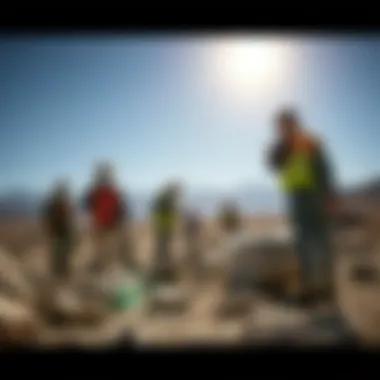
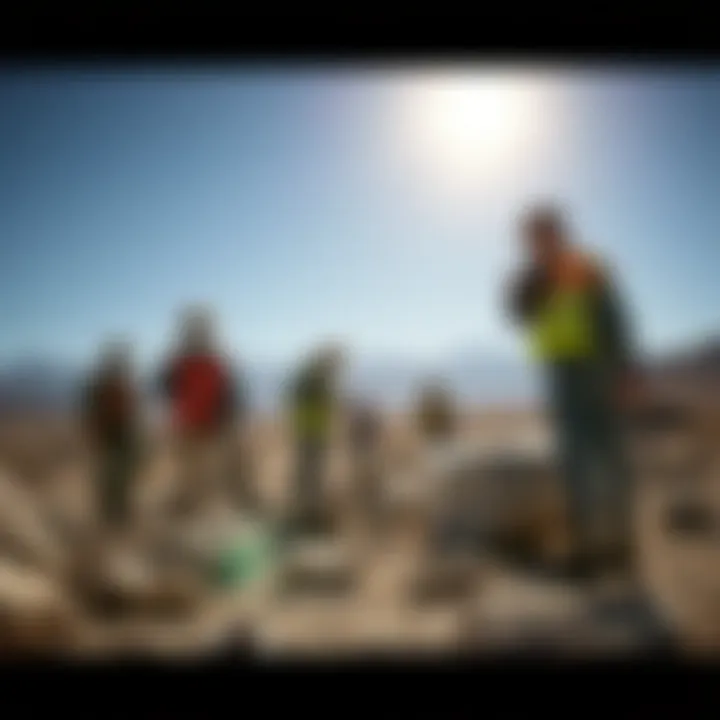
Once you arrive, the various viewing points around Racetrack Playa offer ample opportunities for observation. The best spots are near the rocks themselves, giving onlookers the chance to examine the tracks left behind in detail. Here are a few noteworthy points for visitors:
- Racetrack Playa Access Road: This road is well-marked and leads directly to the playa. Be sure to check conditions before venturing out, as rains can lead to closures.
- Playa Circuits: There are established paths that enable visitors to walk around the playa and get close to the rocks, making exploration more enjoyable.
- Temperature Considerations: Death Valley is known for scorching temperatures. So, plan visits either early in the morning or later in the afternoon to avoid the heat.
Common Misconceptions
With the fame surrounding the moving rocks, it's no surprise that misconceptions spring up among curious minds. Here are some common misunderstandings visitors often encounter:
- Myths of Alien Activity: One of the more outlandish tales includes extraterrestrial involvement in the rock movements. Of course, science provides a different narrative grounded in nature.
- Rocks on the Move Day and Night: Many assume that the rocks shift continuously. However, the movement occurs under specific conditions, primarily during cold, wet periods that allow fine ice to form under the rock.
- Size and Weight of the Rocks: In photographs, these rocks can appear weightless and light, fooling many into believing they are small pebbles. In reality, some can weigh several hundred pounds.
Visitors leave Death Valley with varying levels of understanding, from the scientific to the anecdotal. These shared and often conflicting observations enhance discussions whether amongst friends, online forums, or local guides. Ultimately, the moving rocks capture the imagination, helping to bridge the worlds of geology and human curiosity.
Implications for Geology and Environmental Science
The peculiar phenomenon of moving rocks in Death Valley presents a myriad of implications that resonate throughout both geological science and environmental awareness. These stones, often called racetrack stones, are more than just a curious spectacle; they serve as a lens through which we can better understand Earth’s geological processes and the intricate connections within its ecosystems. Their movements challenge our preconceived notions and open the door to discussions regarding climate, geology, and even conservation efforts.
Impact on Geological Studies
Scientists and researchers look at the moving rocks as a live experiment in nature’s laboratory. By studying these seemingly migrating stones, geologists have the opportunity to explore fundamental questions about erosion, sedimentation, and the impact of climatic conditions on geological formations.
For instance, researchers have been able to identify specific conditions under which these rocks can move—clearly demonstrating the role of ice and moisture in facilitating their journeys across the dry lake bed. The insights gained from studying the mechanics of this movement help refine existing geological models and theories, enabling geologists to better predict similar phenomena in other arid environments worldwide.
Furthermore, these studies encourage geologists to engage in interdisciplinary research. Collaborative efforts between geology, climatology, and environmental science pave the way for new methodologies in understanding not just rocks, but the ecosystems they inhabit. Engaging with the moving rocks phenomenon allows researchers to draw parallels between Earth’s ancient climates and today’s shifting weather patterns, ultimately informing modern-day environmental strategies.
Environmental Awareness and Conservation
The implications extend beyond the realm of geology. Observations made from the moving rocks can foster a deeper awareness of environmental issues affecting arid landscapes. For rock and fossil collectors, understanding this phenomenon highlights the delicate balance between natural processes and human impact.
As more individuals become enthralled with the visual narrative of these moving stones, there lies an opportunity for conservation advocates to educate visitors about the fragile nature of ecosystems like that of Death Valley. The very act of witnessing these rocks can evoke a sense of responsibility towards preserving these unique geological features and their habitats.
"Every stone that glides across the playa tells a story—one that intertwines nature’s forces with our stewardship of the land."
To further bolster environmental awareness, park authorities and local organizations can promote guidelines that encourage respectful interaction with the rocks and the surrounding environment. This will not only help mitigate the potential for damage caused by human activity but also remind visitors that their actions can have lasting effects on these unique geological events.
The End and Future Research
The phenomenon of moving rocks in Death Valley serves as a compelling anecdote in geological studies, particularly regarding the dynamics of our planet's surface. Through examining this intriguing occurrence, we not only gain insights into nature's mechanics but also foster conservation attitudes towards our environment. Understanding how these rocks seemingly wander across the desert floor invites discussion across multiple scientific disciplines, from geology to environmental science. Evaluating the implications can result in enhanced techniques that may inform future research methodologies.
Summary of Key Insights
Diving into the moving rocks of Death Valley not only reveals their movement mechanisms as a thrilling mystery but lays the groundwork for broader conversations about geology as a whole. Several key insights emerge from the exploration:
- Dynamic Interactions: The interplay of ice, water, and wind captures a complex dance that defines the rocks’ rare travel patterns.
- Historical Perspectives: A historic lens reveals how perceptions and scientific hypotheses have evolved over time, underscoring humanity's enduring curiosity.
- Visitor Engagement: Not just a scientific inquiry, but a visitor experience adds a rich layer, with many drawn to witness this natural spectacle firsthand.
- Environmental Concerns: Recognizing the delicate conditions necessary for the rocks’ movement emphasizes the importance of environmental stewardship.
These insights coalesce into a vivid narrative of not just rocks but of our relationship with the earth itself, as well as the ongoing pursuit of knowledge in the face of natural wonders.
Potential Areas for Further Investigation
As the study of moving rocks in Death Valley continues, several avenues warrant exploration. Notably, the continued monitoring of these rocks can facilitate advanced understanding. Future research might focus on:
- Long-term Monitoring Systems: Implementing technology for continuous observation could yield new data on movement patterns.
- Climate Influence Studies: Investigating how climate changes may affect the conditions necessary for movement can link to broader environmental shifts.
- Comparative Geography: Looking into similar phenomena across other regions could result in a wider understanding of geological behaviors.
- Visitor Impact Studies: Understanding how human interaction affects the delicate environment surrounding these rocks can build awareness for preservation strategies.
The journey does not end here; each finding opens new doors to questions yet to be answered, ensuring that the lore of Death Valley continues to engage curious minds.
References and Further Reading
Understanding the fascinating phenomenon of moving rocks in Death Valley requires a deep dive into the wealth of information available from various sources. This section outlines key references and suggested further readings that will enrich your grasp of the topic, providing clarity and depth to the scientific inquiries made throughout the article.
Scientific Journals and Articles
Scientific literature serves as the backbone of research into the moving rocks of Death Valley. Peer-reviewed journals are essential for accessing groundbreaking studies and findings that contribute to the understanding of this remarkable occurrence. Accessing these resources can help enthusiasts and researchers alike:
- Gain insights into experimental methods used to study the phenomenon.
- Find detailed analyses of climatic and geological variables influencing rock movement.
- Read case studies documenting specific instances of rock movement over time.
For those interested, reputable journals like Geophysical Research Letters and Earth Surface Processes and Landforms often publish relevant findings.
You can explore these journals on platforms such as:
Books and Documentaries
Books and documentaries offer a broader context and narrative that can complement scientific articles. They provide storytelling that brings the moving rocks phenomenon to life, weaving in historical facts and geological significance with engaging narratives. Consider examining the following:
- “The Explorations of Death Valley” by Steven J. Simkin: This book delves into the unique features of Death Valley, including the moving rocks, with rich descriptions and illustrations.
- “Geology Underfoot in Death Valley and the Eastern Sierra” by Dale and Mary C. S. S. McLain: An accessible resource detailing geological wonders with a focus on Death Valley.
- Documentary Series like ‘Earth’s Extraordinary Wonders’: These series often cover unique geological features, including segments dedicated to Death Valley and its moving rocks.
Additionally, platforms like YouTube have various documentaries that provide visual insights into the phenomenon, presenting both expert interviews and stunning visuals of the landscape.
In the realm of geology, the right references help decode nature’s curiosity, leading enthusiasts and scientists to a clearer understanding and appreciation of our dynamic planet.
Through exploring these scholarly works and engaging narratives, readers can develop a comprehensive understanding of the incredible phenomenon found in Death Valley. Enhancing one’s knowledge through these resources not only benefits rock enthusiasts but also furthers appreciation for the complexities of Earth’s natural systems.



